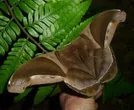
Harmful Effects of Grote's buckmoth
A species of Hemileuca
Direct contact with grote's buckmoth larvae hair can cause allergic reactions, ranging from mild irritation to severe rash, in susceptible individuals. The health risks are generally not life-threatening but may require medical attention for those with severe reactions. Avoiding contact is recommended to prevent these symptoms.
Does the Grote's buckmoth cause allergies?
Harmful Facts About Grote's buckmoth









AI entomologist in your pocket
Scan QR code to download

